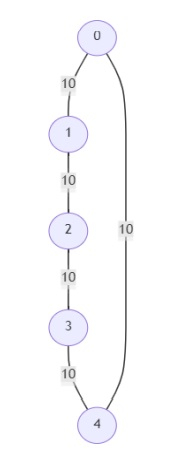
 Data Structure
Data Structure Networking
Networking RDBMS
RDBMS Operating System
Operating System Java
Java MS Excel
MS Excel iOS
iOS HTML
HTML CSS
CSS Android
Android Python
Python C Programming
C Programming C++
C++ C#
C# MongoDB
MongoDB MySQL
MySQL Javascript
Javascript PHP
PHP
- Selected Reading
- UPSC IAS Exams Notes
- Developer's Best Practices
- Questions and Answers
- Effective Resume Writing
- HR Interview Questions
- Computer Glossary
- Who is Who
Program to find out the critical and pseudo-critical edges in a graph in Python
Suppose, we are given a graph that contains n vertices numbered 0 to n -1. The graph is undirected and each edge has a weight. So given the graph, we have to find out the critical and the pseudo-critical edges in the graphs MST. An edge is called a critical edge if deletion of that edge causes the MST weight to increase. A pseudo-critical edge is an edge that can appear in all the graphs MSTs, but not all. We find out the index of the edges given the graph as input.
So, if the input is like

and number of vertices is 5, then the output will be [[], [0, 1, 2, 3, 4]] There are no critical edges in the given graph and all the edges are pseudo-critical. As all the edges have the same weight, any 3 edges from the graph will make an MST.
To solve this, we will follow these steps −
Define a function find_mst() . This will take num_vertices, graph, init := null, exl := null
Define one helper function visit() . This will take u
k[u] := True
-
for each v, w in of graph[u, an empty list], do
-
if exl and u is in exl and v is in exl, then
go for next iteration
-
if not k[v] is True, then
push triplet (w,u,v) into heap tmp
-
res := 0
k := a new list of size num_arrays containing value False
tmp := a new heap
-
if init is non-null, then
u := init
v := init
w := init
res := res + w
k[u] := True
k[v] := True
visit(u) or visit(v)
-
otherwise,
visit(0)
-
while tmp is not empty, do
w := pop smallest item from heap tmp
u := pop smallest item from heap tmp
v := pop smallest item from heap tmp
-
if k[u] and k[v] is non-zero, then
go for next iteration
res := res + w
-
if not k[u] is True, then
visit(u)
-
if not k[v] is True, then
visit(v)
return res if all of k are True, otherwise return infinity
From the main method, do the following:
graph := given graph
temp := find_mst(num_vertices, graph)
c_edge := a new list
p_edge := a new list
-
for i in range 0 to size of edges, do
-
if find_mst(num_vertices, graph, exl = edges[i, index 2 to end]) > temp, then
insert i at the end of c_edge
-
otherwise, if find_mst(num_vertices, graph, init = edges[i]) is same as temp, then
insert i at the end of p_edge
-
return [c_edge, p_edge]
Example
Let us see the following implementation to get better understanding
from heapq import heappop, heappush
def solve(num_vertices, edges):
graph = dict()
for u, v, w in edges:
graph.setdefault(u, []).append((v, w))
graph.setdefault(v, []).append((u, w))
temp = find_mst(num_vertices, graph)
c_edge, p_edge = [], []
for i in range(len(edges)):
if find_mst(num_vertices, graph, exl = edges[i][:2]) > temp:
c_edge.append(i)
elif find_mst(num_vertices, graph, init = edges[i]) == temp:
p_edge.append(i)
return [c_edge, p_edge]
def find_mst(num_vertices, graph, init = None, exl = None):
def visit(u):
k[u] = True
for v, w in graph.get(u, []):
if exl and u in exl and v in exl:
continue
if not k[v]:
heappush(tmp, (w, u, v))
res = 0
k = [False] * num_vertices
tmp = []
if init:
u, v, w = init
res += w
k[u] = k[v] = True
visit(u) or visit(v)
else:
visit(0)
while tmp:
w, u, v = heappop(tmp)
if k[u] and k[v]: continue
res += w
if not k[u]:
visit(u)
if not k[v]:
visit(v)
return res if all(k) else inf
print(solve(5, [[0,1,10],[1,2,10],[2,3,10],[3,4,10],[4,0,10]]))
Input
5, [[0,1,10],[1,2,10],[2,3,10],[3,4,10],[4,0,10]]
Output
[[], [0, 1, 2, 3, 4]]

